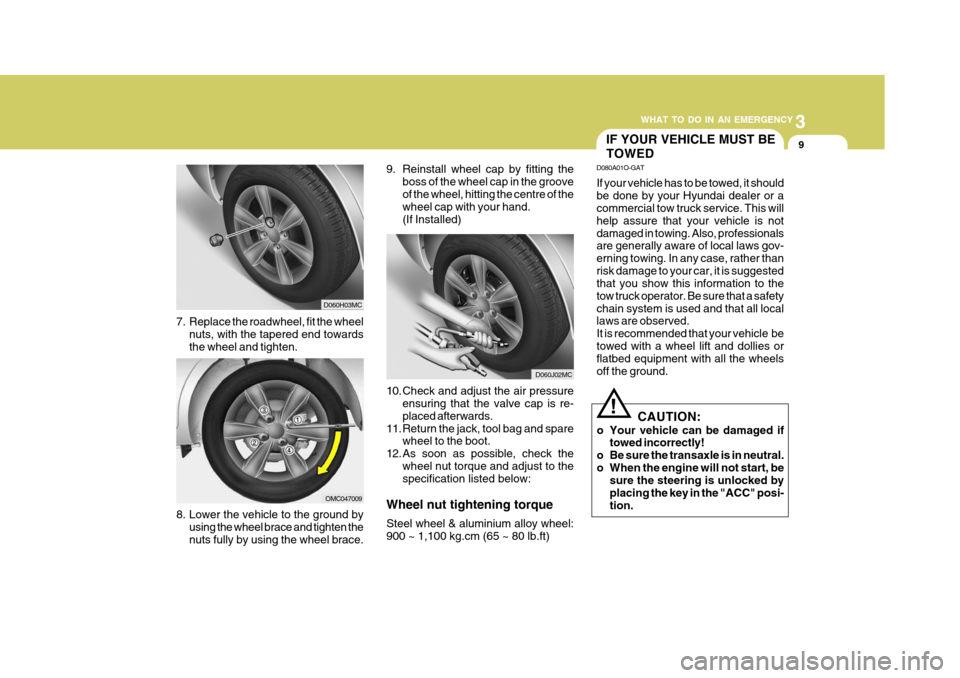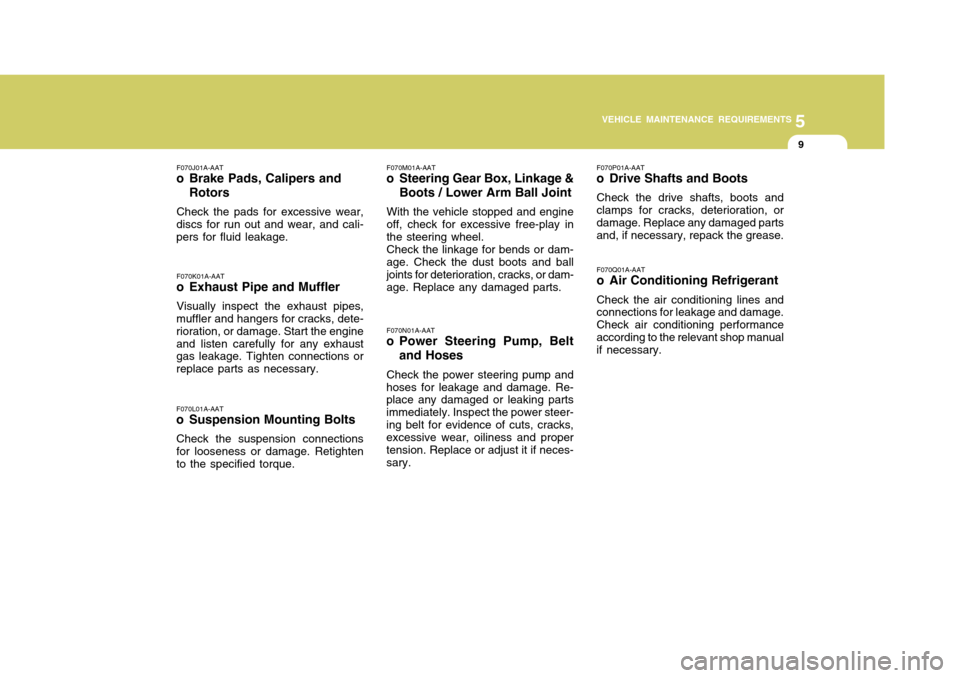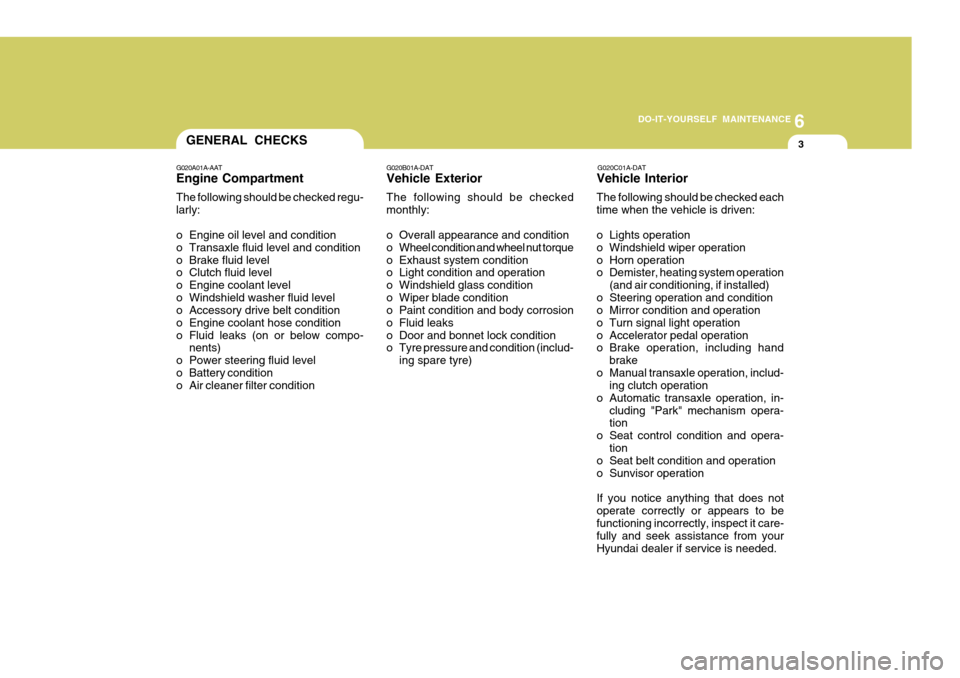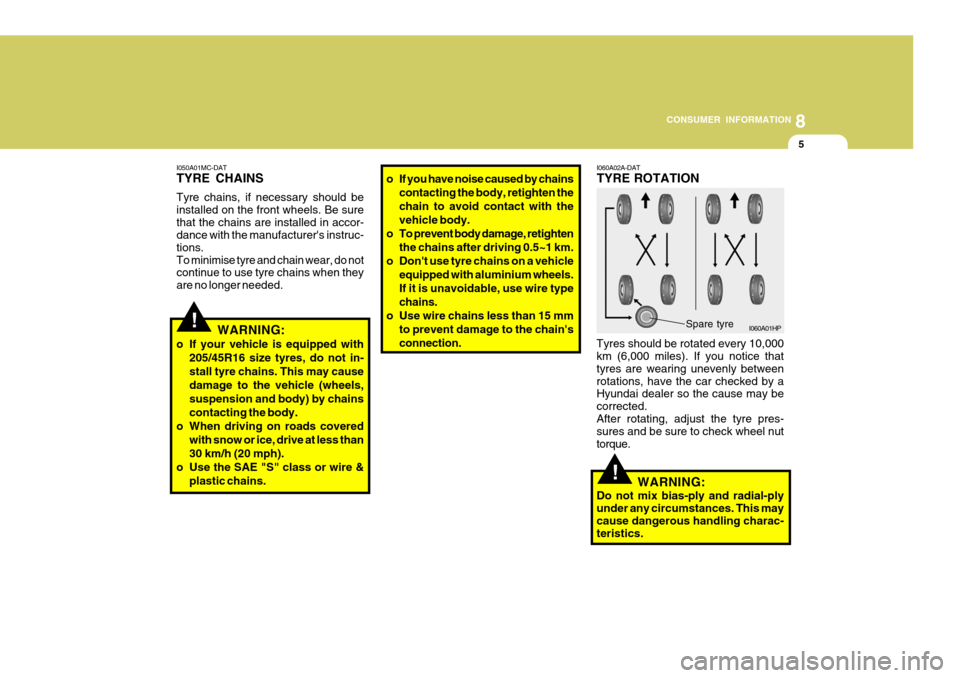Page 161 of 232

3
WHAT TO DO IN AN EMERGENCY
9
8. Lower the vehicle to the ground by using the wheel brace and tighten the nuts fully by using the wheel brace. 10. Check and adjust the air pressure
ensuring that the valve cap is re-placed afterwards.
11. Return the jack, tool bag and spare wheel to the boot.
12. As soon as possible, check the wheel nut torque and adjust to the specification listed below:
Wheel nut tightening torque Steel wheel & aluminium alloy wheel: 900 ~ 1,100 kg.cm (65 ~ 80 lb.ft)
7. Replace the roadwheel, fit the wheel
nuts, with the tapered end towards the wheel and tighten.
D060H03MC
OMC047009
D060J02MC
IF YOUR VEHICLE MUST BE TOWED
D080A01O-GAT If your vehicle has to be towed, it should be done by your Hyundai dealer or a commercial tow truck service. This will help assure that your vehicle is notdamaged in towing. Also, professionals are generally aware of local laws gov- erning towing. In any case, rather thanrisk damage to your car, it is suggested that you show this information to the tow truck operator. Be sure that a safetychain system is used and that all local laws are observed. It is recommended that your vehicle betowed with a wheel lift and dollies or flatbed equipment with all the wheels off the ground.
! CAUTION:
o Your vehicle can be damaged if towed incorrectly!
o Be sure the transaxle is in neutral.
o When the engine will not start, be sure the steering is unlocked byplacing the key in the "ACC" posi-tion.
9. Reinstall wheel cap by fitting the
boss of the wheel cap in the grooveof the wheel, hitting the centre of the wheel cap with your hand. (If Installed)
Page 181 of 232

5
VEHICLE MAINTENANCE REQUIREMENTS
9
F070L01A-AAT
o Suspension Mounting Bolts
Check the suspension connections for looseness or damage. Retighten to the specified torque. F070M01A-AAT
o Steering Gear Box, Linkage &
Boots / Lower Arm Ball Joint
With the vehicle stopped and engineoff, check for excessive free-play in the steering wheel. Check the linkage for bends or dam- age. Check the dust boots and ball joints for deterioration, cracks, or dam- age. Replace any damaged parts. F070N01A-AAT
o Power Steering Pump, Belt
and Hoses
Check the power steering pump and
hoses for leakage and damage. Re- place any damaged or leaking parts immediately. Inspect the power steer-ing belt for evidence of cuts, cracks, excessive wear, oiliness and proper tension. Replace or adjust it if neces-sary. F070P01A-AAT
o Drive Shafts and Boots
Check the drive shafts, boots andclamps for cracks, deterioration, or damage. Replace any damaged parts and, if necessary, repack the grease. F070Q01A-AAT
o Air Conditioning Refrigerant Check the air conditioning lines and connections for leakage and damage. Check air conditioning performanceaccording to the relevant shop manual if necessary.
F070J01A-AAT
o Brake Pads, Calipers and
Rotors
Check the pads for excessive wear,
discs for run out and wear, and cali-pers for fluid leakage.
F070K01A-AAT
o Exhaust Pipe and Muffler
Visually inspect the exhaust pipes,
muffler and hangers for cracks, dete- rioration, or damage. Start the engineand listen carefully for any exhaust gas leakage. Tighten connections or replace parts as necessary.
Page 184 of 232

6
DO-IT-YOURSELF MAINTENANCE
3GENERAL CHECKS
G020A01A-AAT Engine Compartment The following should be checked regu- larly:
o Engine oil level and condition
o Transaxle fluid level and condition
o Brake fluid level
o Clutch fluid level
o Engine coolant level
o Windshield washer fluid level
o Accessory drive belt condition
o Engine coolant hose condition
o Fluid leaks (on or below compo- nents)
o Power steering fluid level
o Battery condition
o Air cleaner filter condition G020C01A-DAT Vehicle Interior The following should be checked each time when the vehicle is driven:
o Lights operation
o Windshield wiper operation
o Horn operation
o Demister, heating system operation
(and air conditioning, if installed)
o Steering operation and condition
o Mirror condition and operation
o Turn signal light operation
o Accelerator pedal operation
o Brake operation, including hand
brake
o Manual transaxle operation, includ- ing clutch operation
o Automatic transaxle operation, in- cluding "Park" mechanism opera-tion
o Seat control condition and opera- tion
o Seat belt condition and operation
o Sunvisor operation If you notice anything that does not operate correctly or appears to befunctioning incorrectly, inspect it care- fully and seek assistance from your Hyundai dealer if service is needed.
G020B01A-DAT Vehicle Exterior The following should be checked monthly:
o Overall appearance and condition
o Wheel condition and wheel nut torque
o Exhaust system condition
o Light condition and operation
o Windshield glass condition
o Wiper blade condition
o Paint condition and body corrosion
o Fluid leaks
o Door and bonnet lock condition
o Tyre pressure and condition (includ-
ing spare tyre)
Page 221 of 232

8
CONSUMER INFORMATION
5
!
I060A01HP
I060A02A-DAT TYRE ROTATION
Tyres should be rotated every 10,000 km (6,000 miles). If you notice that tyres are wearing unevenly betweenrotations, have the car checked by a Hyundai dealer so the cause may be corrected.After rotating, adjust the tyre pres- sures and be sure to check wheel nut torque. WARNING:
Do not mix bias-ply and radial-plyunder any circumstances. This may cause dangerous handling charac- teristics.
Spare tyre!
I050A01MC-DAT TYRE CHAINS Tyre chains, if necessary should be installed on the front wheels. Be surethat the chains are installed in accor- dance with the manufacturer's instruc- tions.To minimise tyre and chain wear, do not continue to use tyre chains when they are no longer needed.
WARNING:
o If your vehicle is equipped with 205/45R16 size tyres, do not in- stall tyre chains. This may causedamage to the vehicle (wheels,suspension and body) by chainscontacting the body.
o When driving on roads covered with snow or ice, drive at less than30 km/h (20 mph).
o Use the SAE "S" class or wire & plastic chains. o If you have noise caused by chains
contacting the body, retighten thechain to avoid contact with thevehicle body.
o To prevent body damage, retighten the chains after driving 0.5~1 km.
o Don't use tyre chains on a vehicle equipped with aluminium wheels.If it is unavoidable, use wire typechains.
o Use wire chains less than 15 mm to prevent damage to the chain'sconnection.